In this article you’ll learn about:
- How AI search really works including semantic indexing, large language models, and knowledge graphs and what it means for your life science SEO strategy.
- Quick wins to boost trust and visibility by creating educational, structured content aligned with how AI tools like ChatGPT, Gemini, and Perplexity rank.
- How to layer AI search best practices into your life science SEO workflow and streamlining efforts and focusing on what drives real visibility and impact.
When bringing a novel, disruptive life science technology to market, earning your audience’s trust is crucial, and education is the fastest way to do it. In today’s evolving search landscape, educational content must span multiple channels. Visibility now means more than ranking on Google, it’s about being discoverable, skimmable, and contextually relevant across AI summaries, tools like ChatGPT, Gemini, and Perplexity, voice assistants, and internal LLMs.
There’s a lot of buzz about the future of search, and there’s a lot of things we don’t know right now but what we do know is that the search, click, repeat paradigm is over. And the new human AI interaction model for knowledge information is forcing companies to rethink their life science SEO strategies. Life science customers may type something into a search bar, or may be having a chat in a chat window, it may happen in voice, or on screen. At this time, we don’t know where the life science consumer is going to go with this but there’s a lot of paradigm shifts underway and it’s important to stay steady and diversify strategies.
Specifically, my advice to life science marketers is to continue strong technical SEO while incorporating emerging best practices for AI-powered search. Typically, I’ve found with change, success lies in building on proven foundations, not replacing them, and slowly evolving with new trends.
With AI evolving at warp speed, it’s easy to feel behind. But here’s the upside: success in AI search comes down to three basic tenets:
- Produce concise, well-researched educational content. Leverage structured formatting, clear headings, schema markup, bullet points, and tables to boost readability and scannability.
- Establish a consistent brand presence across all channels. Unified messaging reinforces authority and trust, helping AI tools and search engines recognize your brand as a credible source.
- Focus on high-impact technical SEO. Surface priority pages in your site architecture, improve load speeds, and remove clutter to enhance crawlability and search performance.
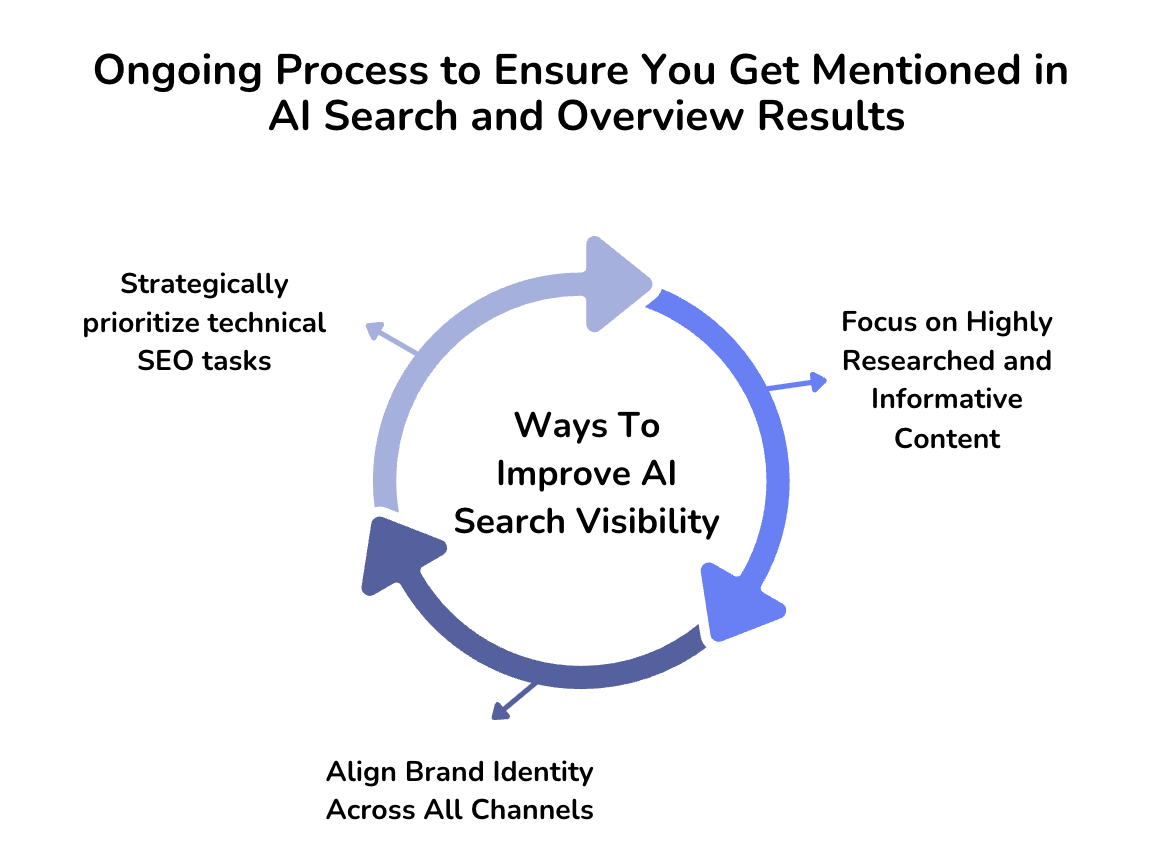
In the following sections, we’ll unpack why AI search matters, how they actually work and in comparison to traditional life science seo, and share practical tips to boost discoverability. We also offer an AI Visibility Scorecard to help you spot strengths and gaps in your current content.
Ok, let’s get started.
Why AI Search Matters for Building Trust and Educating Around Disruptive Life Science Tech
AI search is quickly becoming the first touchpoint for how people learn about emerging technologies. For disruptive life science brands, getting mentioned in AI-generated overviews or AI tools, isn’t just about visibility, it’s about credibility. Disruptive life science technologies often challenge the status quo, so building trust requires clear, consistent and educational content that answers real questions and reduces uncertainty. When AI tools surface your brand as a reliable source, you’re not just informing, you’re shaping perception and accelerating adoption of your novel technology.
Publishing content around quality, transparency, and real-world application reinforces your value. After all, disruptive tech exists to solve hard problems in better ways. But without trust, even the most brilliant innovation can fail in the market. Show up consistently, be useful, and the trust and customer adoption will follow.
What Is AI Search
Gone are the days when scientists and life science professionals relied solely on Google and PubMed. Today’s users are bouncing between life science SEO Google search, ChatGPT, Claude, Perplexity, Gemini, and Grok, AI voice assistants, LLM-powered internal tools, Slack channels, and specialized scientific engines like ModernVivo to retrieve information.
Each of these platforms has its own logic and signals and any one of them could be where your brand gets discovered. If your content isn’t optimized across this constellation of entry points, you’re invisible.
Now, life science SEO has shifted from optimizing around individual keywords to building comprehensive, well-structured content around entire topics. To succeed today, your content must thoroughly answer a range of user questions, demonstrate subject-matter depth, and be easy for both people and algorithms to scan, interpret, and trust.
In Sciencia’s AI tool research lab, we’re seeing measurable improvements in how life science SEO content is recognized and ranked in AI search. Scientific images are also improving in quality. So in the life science industry, AI search isn’t optional, it’s becoming essential.
In the past, you could rank for “best CRISPR editing tool” just by repeating the phrase—regardless of content quality. Today, ranking requires actually answering the broader question: What is CRISPR? How does it work? How is it used? What tools are available, how do they compare, and which ones are suited for specific applications? And all of this needs to be delivered in an informative, skimmable, and well-structured format.
It’s also essential to understand common user questions and how different tools stack up based on real-world needs.
We ran a quick test using the prompt: “What is the best gene editing tool?” Here’s how the major AI engines responded:
- Google AI Overviews Took the diplomatic route, “each tool has pros and cons,” citing peer-reviewed sources.

- Gemini: Focused on CRISPR with no references, but offered to write a custom research report. Impressive initiative.
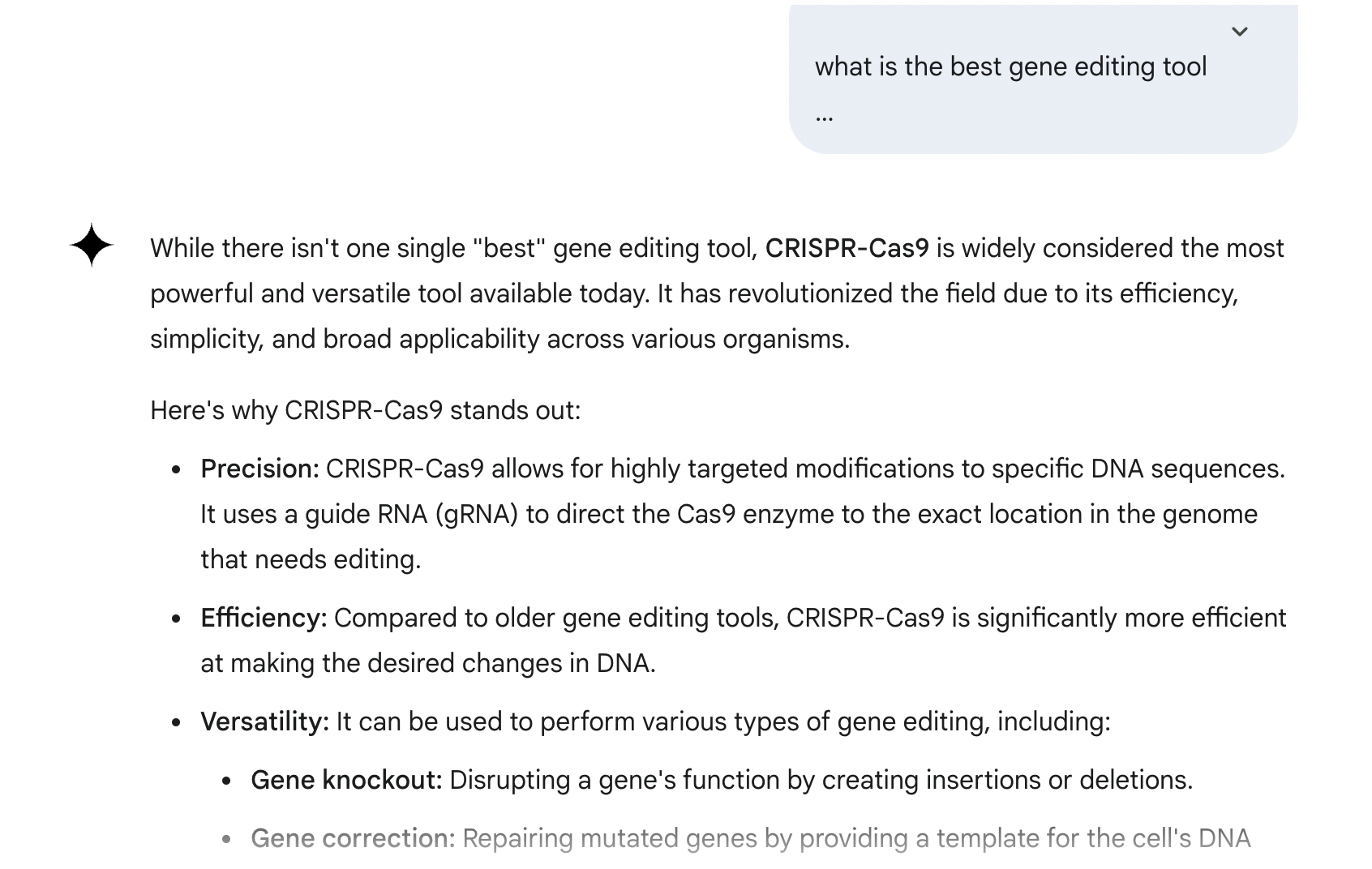
- ChatGPT: Pragmatically stated “best” depends on your goals. The tone felt conversational, and it included a helpful table, though no references.
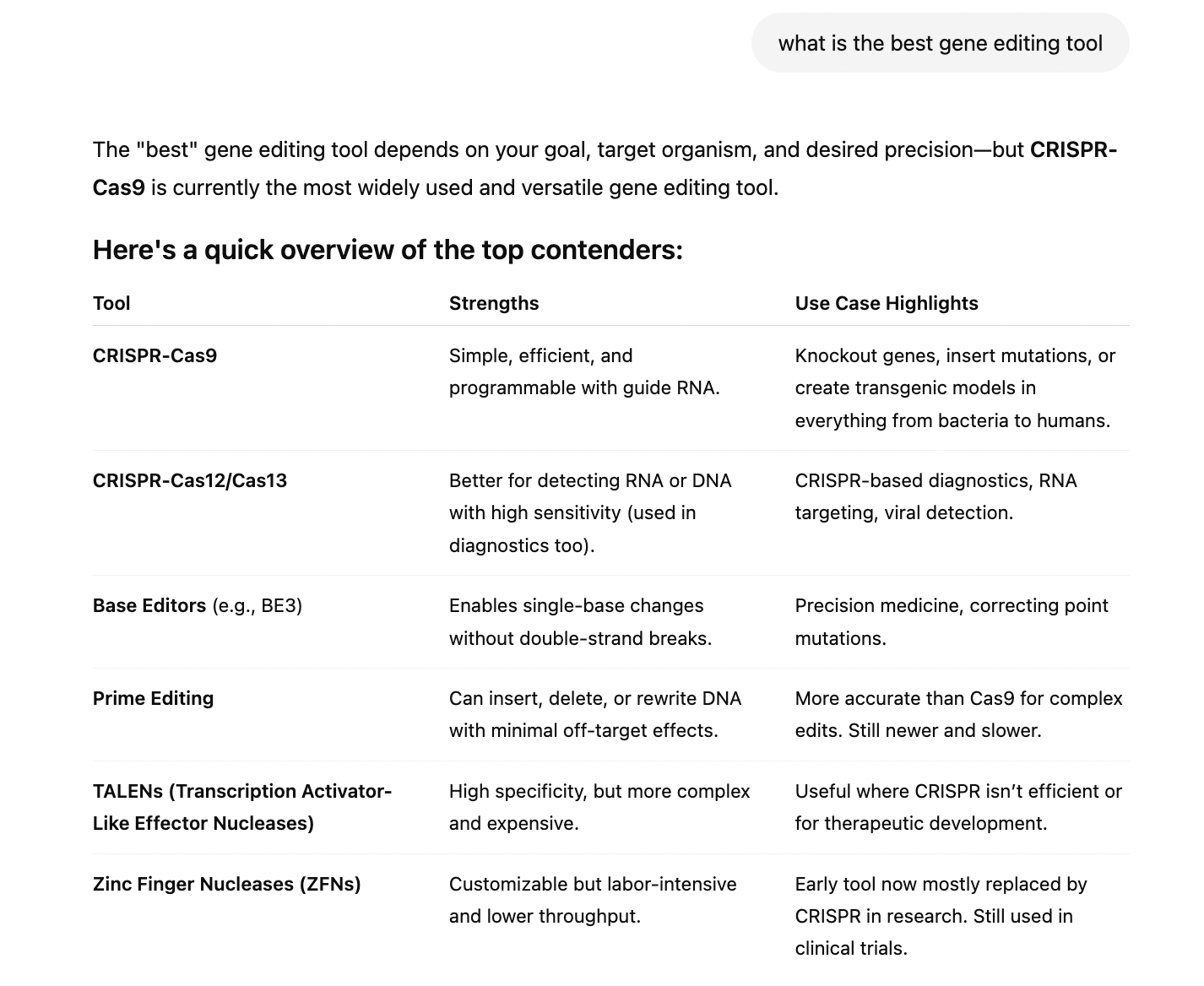
- Perplexity: Offered a nice summary and table, solid references, but leaned more on credible companies and organizations rather than peer-reviewed papers.
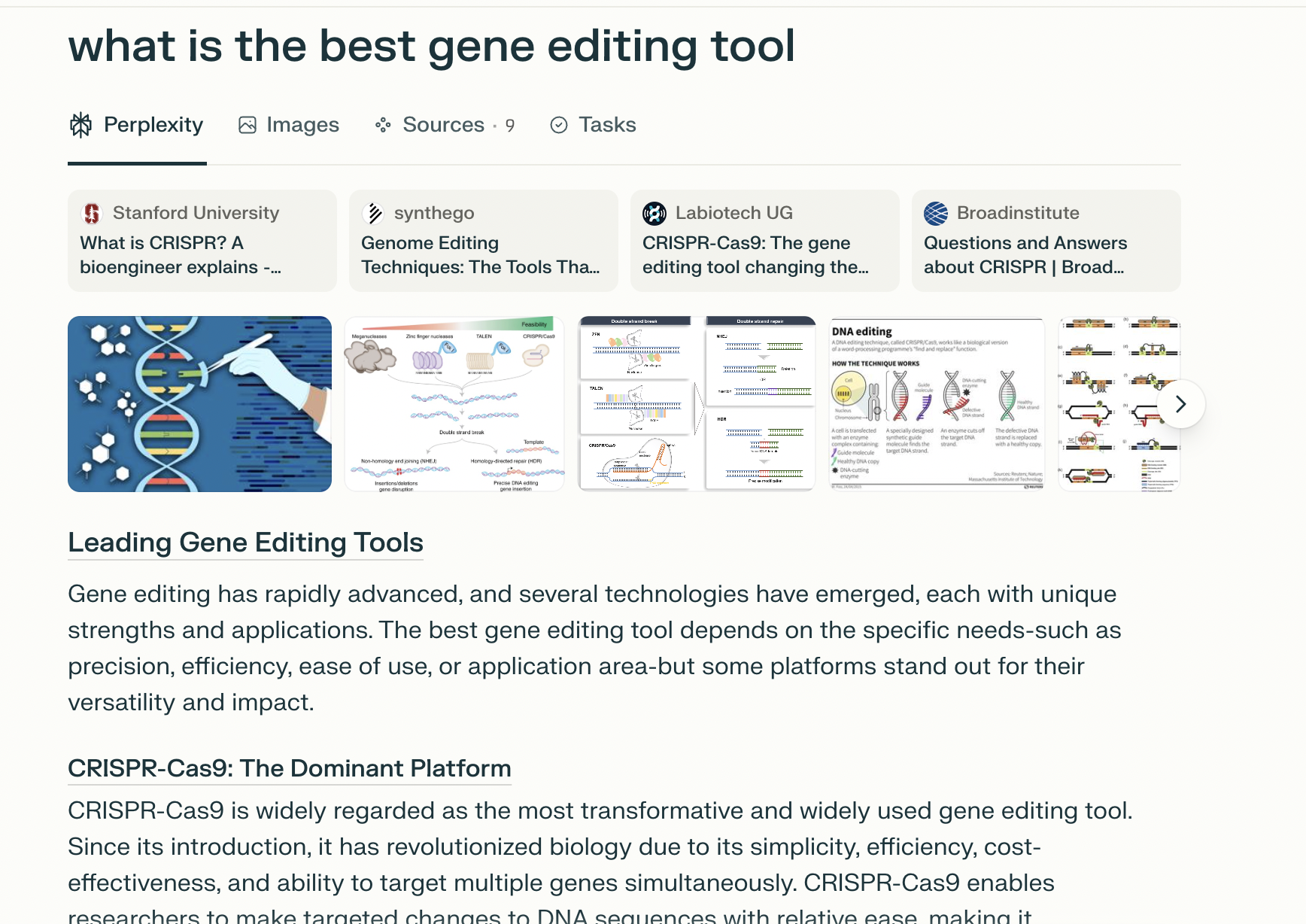
- Grok: No hesitation. CRISPR is the best, period. Bold take, minimal nuance.
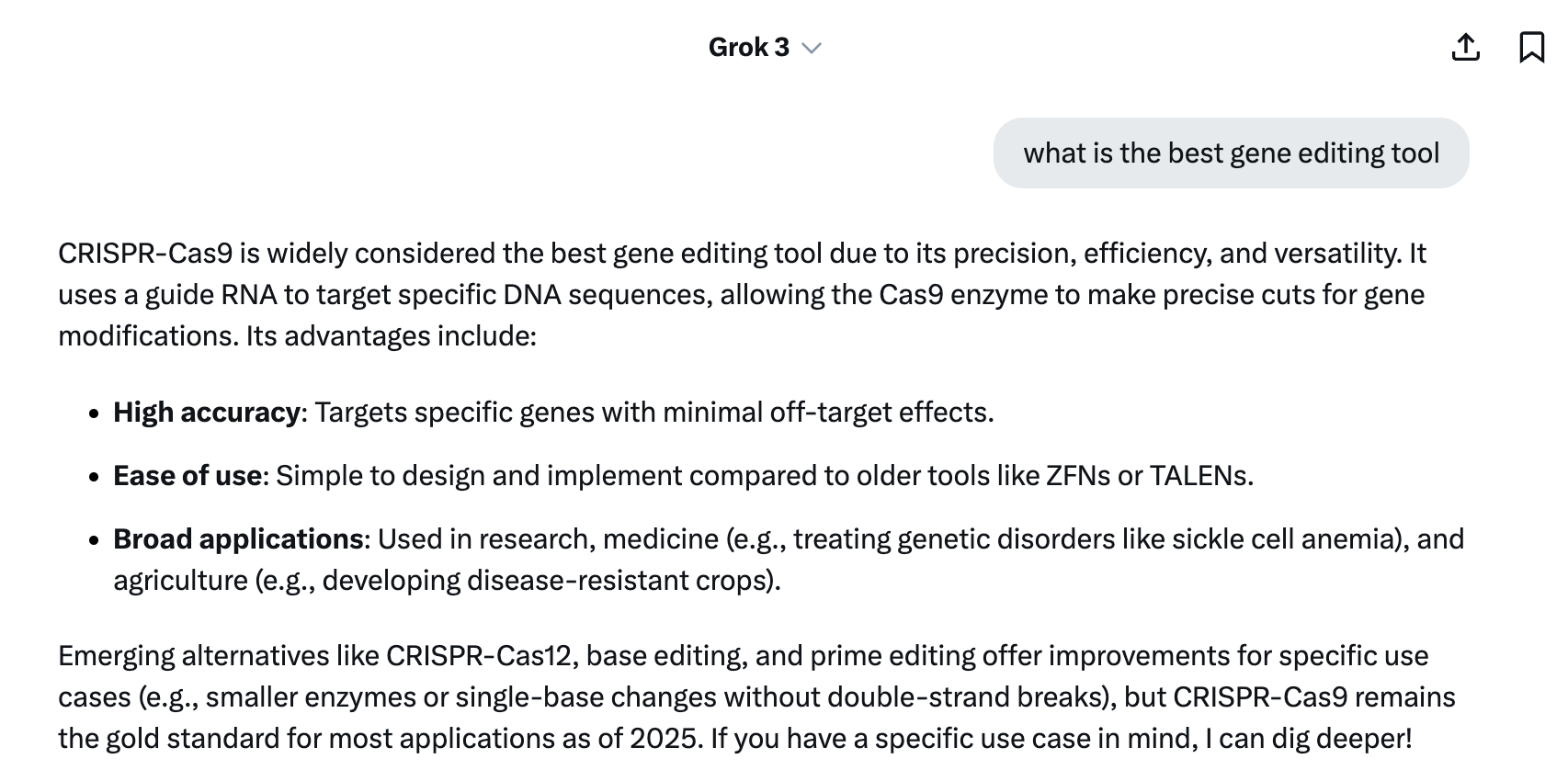
- PubMed: For our control group, we used PubMed which, while still valuable, runs on outdated software and highlights just how far scientific search has evolved in this new era.
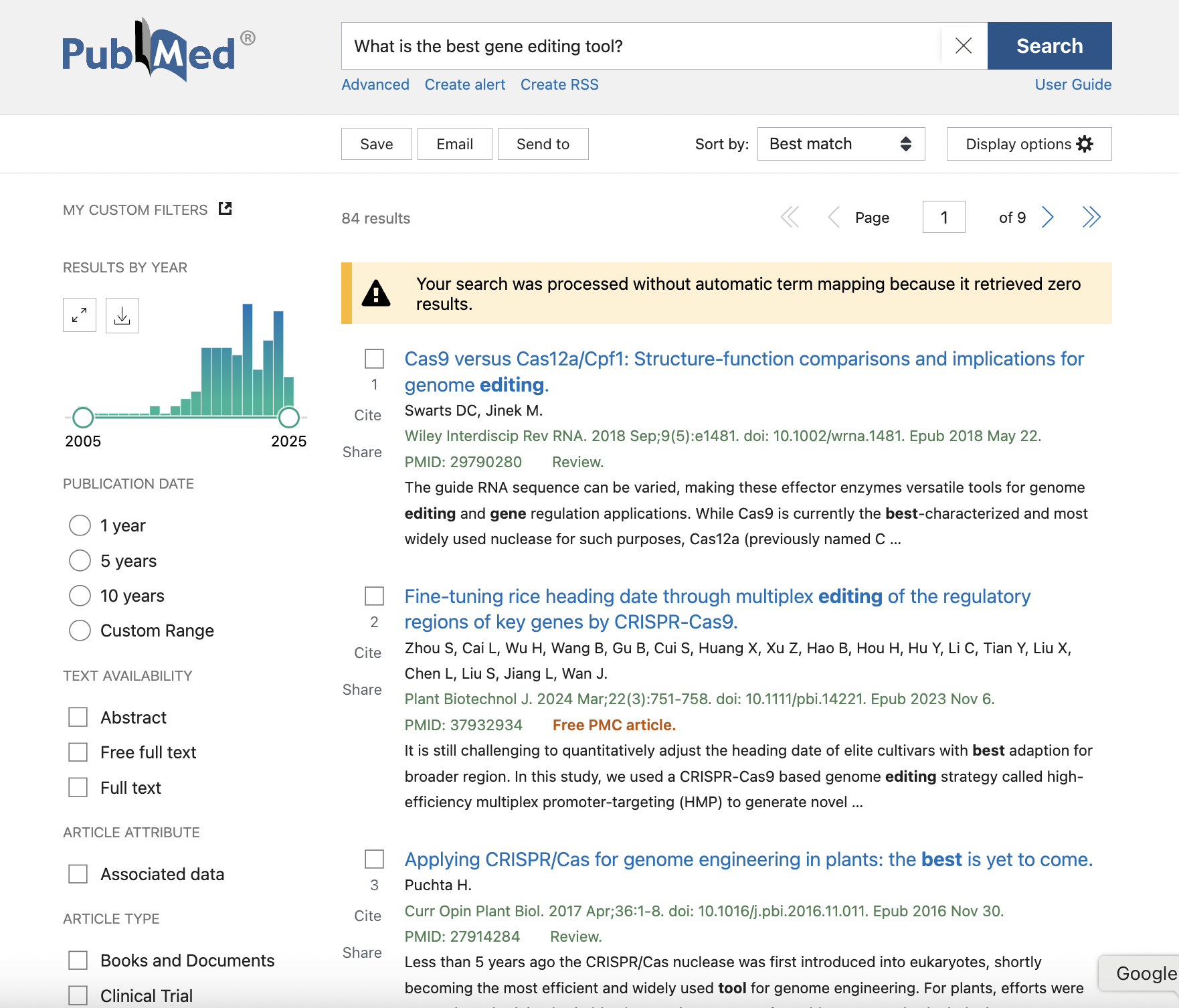
How AI Search Works
 AI-powered search has moved far beyond simple keyword matching. Instead, it uses vector embeddings; mathematical representations that capture the meaning of words, sentences, and entire documents in a multidimensional space. Think of your content not as a collection of keywords, but as a coordinate in a meaning map. Search engines like Google’s search generative experience (SGE) or Perplexity AI interpret queries by matching intent, context, and semantic similarity, not just strings of text.
AI-powered search has moved far beyond simple keyword matching. Instead, it uses vector embeddings; mathematical representations that capture the meaning of words, sentences, and entire documents in a multidimensional space. Think of your content not as a collection of keywords, but as a coordinate in a meaning map. Search engines like Google’s search generative experience (SGE) or Perplexity AI interpret queries by matching intent, context, and semantic similarity, not just strings of text.
To show up in this new world of search, your content must do more than check boxes, it has to teach, resonate, and connect the dots.
What Fuels AI Search Visibility?
To rank in the new era of AI-powered search, life science seo content must go beyond keywords and clicks. Visibility now depends on how well your content communicates relevance, originality, and authority to both humans and machines. The table below highlights five core drivers of AI search visibility, each one critical to shaping how your brand shows up in AI-generated summaries, voice results, and scientific tool recommendations.
| Visibility Driver | Why It Matters | How to Execute in Life Sciences |
| Originality over repetition | AI search engines deprioritize stale, regurgitated content. | Provide a fresh perspective on topics. Avoid duplicating what’s already known. Use internal research or case studies to support your unique perspective. |
| Depth backed by data | Educational, well-researched content gains more authority, especially in technical fields. | Cite peer-reviewed studies, include expert commentary, and highlight emerging research or trends. |
| Semantic clarity wins | Natural, question-based phrasing improves retrieval by AI models trained on human-like language patterns. | Use FAQs, long-tail questions, and conversational language. Reflect how scientists actually search for information. |
| Structured content, structured data | Clean formatting and metadata help AI interpret content more accurately. | Use headers, bullets, schema markup, SEO-optimized title tags and meta descriptions written in plain, easy-to-understand wording. |
| External validation matters | Authority signals from outside your website—especially in respected scientific ecosystems—boost trust and reach. | Build backlinks, co-author papers, and collaborate with PR experts to place your brand in relevant high authority journals. Boosting up your LinkedIN social media cadence helps as well. |
Your Brand Isn’t What You Declare; It’s What AI Infers
AI-powered search engines prioritize what the broader digital ecosystem conveys and, more critically, what can be inferred. AI components, including large language models (LLMs) and knowledge graphs, shape brand perceptions by identifying patterns, cross-referencing claims, analyzing third-party mentions, seeking supporting data, and detecting inconsistencies.
AI is great at connecting dots from various places and it looks for life science seo content that’s semantically close, even if it doesn’t contain those exact words. So that’s different from traditional life science SEO.

Alas, not all AI search engines are built the same. To build a truly omnisearch optimized life science seo content engine, you need to tailor your content to match the unique priorities of each platform.
- Google Still values site maps, authoritative links, and helpful content, but it’s becoming increasingly sensitive to semantic nuance.
- ChatGPT and Gemini, Prioritize clarity, specificity, and verifiable evidence.
- Perplexity Reward credibility, favoring citations over conjecture but also scraps the web in real time so Google life science SEO best practices still apply.
- Grok: Prefers bold, confident answers. It’s less about nuance and more about conviction; if your content takes a clear stance and reads with authority, Grok’s more likely to surface it. Just don’t expect footnotes.
So with this search everywhere, aka omnisearch, it isn’t about gaming the system, it’s about learning about and aligning with how modern life science SEO discovery engines operate. In short: it’s not just about sharing unique insights and educating audiences, it’s about ensuring the algorithms recognize it.
Quick Scoop on Google’s AI Overviews
By now, most of you have probably experimented with various AI tools. But if you’re like me, you still rely on good old-fashioned Google searches. Recently, Google introduced AI Overviews—machine-generated summaries that appear at the top of some search results. These overviews pull insights from multiple high-ranking sources to deliver quick, concise answers—so users can get what they need without clicking through to individual websites.
These summaries typically draw from the top 10–12 search results and hover around 170 words, though longer responses appear for more complex queries. AI Overviews are more likely to show up for long-tail, lower-competition searches, making them a smart target for educational content creators.
Current trends show AI Overviews favor concise, visually clean content with general guidance. To improve your chances of being featured, focus on creating well-structured, skimmable content that delivers authoritative, clearly presented answers. Think step-by-step guides, how-tos, and direct responses. A proven best practice is to include three summary bullet points at the top of your content to highlight key takeaways for both readers and AI. Moreover, they increasingly cite YouTube and video content, so pairing strong text with helpful video is a winning strategy.
Redefining KPIs for AI Search Success
Success in the age of life scienceAI search isn’t just about driving clicks, it’s about being referenced, trusted, and surfaced across a growing ecosystem of generative engines. To stay competitive, marketers must evolve their KPIs to reflect how discovery works with AI search tools and prioritize high-quality, context-rich content that’s easy to cite and summarize. Here’s how to begin rethinking your performance metrics.
| Action Step | What to Do | Rationale |
| Run AI Search Visibility Audits (for no cost solution) | Enter branded and non-branded prompts into AI tools like ChatGPT, Perplexity, and Gemini in incognito mode. Track how and if your brand appears. Capture screenshots, record prompt phrasing, and log results monthly. | Helps monitor how your brand is represented (or not) in AI-generated results and track progress over time. |
| AI Search Visibility Audits
(cost involved) |
In addition to tracking AIO keywords in Ahrefs and SEMrush, we use GPTrends, AIrank, and Waikay. | Helps provide visibility where and where not appearing in AIO. |
| Track Citation Frequency | Focus on where and how often your brand is mentioned even without hyperlinks. Note name drops, quotes, or paraphrased content. Log mentions by source, prompt type, and citation style. | Citations, not just clicks, are emerging indicators of authority in AI search environments. |
| Assess AI Content Accuracy | Review how your brand is described in AI-generated answers. Rate for accuracy, clarity, and message alignment. Use labels like “Accurate,” “Outdated,” or “Misrepresented.” | Informs SEO updates, content corrections, and ensures consistent, credible brand messaging across AI tools. |
10 Key strategies to rank in AI search and AI overview visibility
- Know Your Audience’s Intent
Are they skimming for quick insights or diving deep for detailed analysis? Understanding audience intent helps determine whether AI Overview placement is worth targeting and where in their journey your content fits. - Stick to Core Life Science SEO Best Practices
Fundamentals still count:- Fast site speed
- Strong EEAT (Experience, Expertise, Authoritativeness, Trustworthiness)
- On-page optimization; interlinks; keywords
- Structured content: FAQs, How-Tos
- Schema markup, including video schema
- Create Content Worth Clicking
Don’t just summarize and add value. Use original analysis, proprietary data, visuals, and video. Think beyond what Google can scrape and aim for what only you can say. - Stay Timely and Relevant
Keep evergreen content fresh by updating only specific pieces, there’s no need to go back and optimize everything. Publish new content tied to current trends, recent data, and evolving market conversations. - Go After Low-Hanging Keyword Opportunities
Uncover long-tail questions with low competition (keyword difficulty <20). Target informational terms that haven’t yet been optimized for AI Overviews, featured snippets, or knowledge panels. - Cover the Full Funnel
AI Overviews love top-of-funnel content, but don’t neglect mid- and bottom-funnel opportunities. Examples:- Top: “How AI is transforming regulatory submissions”
- Mid: “3 ways digital strategy boosts trial recruitment”
- Bottom: “Case Study: How we launched an AI regulatory content program in 4 weeks”
- Earn High-Quality Backlinks
Google still leans on authority signals. Backlinks from reputable sources help establish your brand as trustworthy and influential. Seek and find a life science PR professional who can help shape your digital brand narrative. - Simplify, Simplify, Simplify (oh, and did I mention you should simplify?)
Make content easy to scan and understand. Clean, structured, and skimmable always wins. - Invest in Video Content
AI Overviews increasingly surface video results. Use video for tutorials, walkthroughs, and visual comparisons to boost engagement and discoverability. - Establish Brand Authority
While not yet a formal AIO or AI search ranking factor, brand authority is gaining influence. Demonstrate your expertise consistently across channels to stay ahead of the curve.
A-B-C to Jumpstart Your Life Science SEO and AI-Optimized Content Strategy
Feeling a bit overwhelmed? The key is to take small, consistent steps and build your AI content IQ over time. I make it a point to learn one new AI insight each day. We also share regular updates on Sciencia Consulting’s LinkedIn; follow us there for weekly takeaways from our AI content lab and the latest in life science SEO trends.
Also, here are three simple actions you can take today to get the ball rolling:
A. Align Your Teams
Break down silos between SEO, paid media, and PR. AI-powered discovery doesn’t respect departmental boundaries and neither should your content strategy. Coordinate efforts across teams to ensure your brand story is consistent, discoverable, and data-informed from every angle.
B. Benchmark the Right Metrics
Update your KPIs for the AI era. Start tracking:
- How often your content appears in AI Overviews (e.g., Google’s SGE)
- Brand mentions across platforms (ChatGPT, Gemini, Perplexity citations)
- Topic momentum using tools like Google Trends
- Don’t just measure clicks, measure influence. Brand awareness now starts in conversations, not just conversions.
C. Craft Better Top-of-Funnel Content
Choose an educational piece you’re proud of and optimize it for AI search:
- Add a clear, compelling meta title and description
- Include a bullet-point life science SEO summary with key takeaways
- Ensure the writing sounds natural — human phrasing beats robotic fluff
- Embed a short video explainer
- Add a helpful FAQ section to boost clarity and semantic relevance
FREE Life Science SEO and AI Search Visibility Scorecard
Grab your copy of this Google Sheet to audit and enhance your content for AI-driven discoverability.
Start Your AI Optimization Today!
Frequently Asked Questions
Q: How is AI search different from traditional life science SEO?
AI search uses semantic understanding, large language models, and knowledge graphs to interpret meaning not just match keywords. Success now hinges on clarity, topical authority, and content depth, rather than keyword repetition.
Q: Should life science brands prioritize being mentioned in AI-generated search results?
Yes. While Google remains the primary search engine, AI tools are quickly becoming a go-to resource for professionals researching new technologies. Mentions in AI summaries can build credibility, shape perception, and accelerate adoption.
Q: Which AI tools matter most for life science seo and digital marketers?
Prioritize ChatGPT, Gemini, Perplexity, and Google AI Overviews. Claude shows strength in coding and technical workflows, while Grok is bold on strategy and market trends but may be less reliable for scientific audiences.
Q: How can I tell if my life science brand is appearing in AI search results?
Run monthly visibility checks by entering both branded and unbranded prompts into AI platforms. Note how your brand is described, which assets are referenced, and whether the messaging aligns with your positioning.
Q: What’s one fast way to start improving AI search visibility for my life science brand?
Pick a strong educational life science content piece and optimize it: add three bullet-point takeaways, embed a short video, and include a concise FAQ section. This enhances clarity, structure, and AI relevance immediately.




